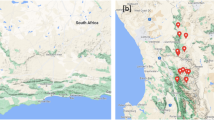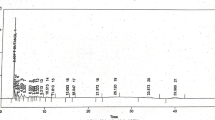Abstract
The aim of metabolic untargeted profiling is to detect and identify unknown compounds in a biological matrix to achieve the most comprehensive metabolic coverage. In phytochemical mixtures, however, the complexity of the sample could present significant difficulties in compound identification. In this case, the optimization of both the chromatographic and the mass-spectrometric conditions is supposed to be crucial for the detection and identification of the largest number of compounds. In this work, a systematic investigation of different chromatographic and mass-spectrometric conditions is presented to achieve a comprehensive untargeted profiling of a strawberry extract (Fragaria × ananassa). To fulfill this aim, an ultra-high-pressure liquid chromatography system coupled via an electrospray source to a hybrid quadrupole–Orbitrap mass spectrometer was used. Spectra were acquired in data-dependent mode, and several parameters were investigated to acquire the largest possible number of both mass spectrometry (MS) features and MS2 mass spectra for unique metabolites. The main classes of polyphenols studied were flavonoids, phenolic acids, dihydrochalcones, ellagitannins, and proanthocyanidins. Method optimization allowed to us identify and tentatively identify 18 and 113 compounds, respectively, among which 74 have never been reported before in strawberries and, to the best of our knowledge, 22 of them have never been reported before. The results show the importance of an extended investigation of the chromatographic and mass-spectrometric method before a complete untargeted profiling of complex phytochemical mixtures.


Similar content being viewed by others
References
Gika HG, Wilson ID, Theodoridis GA. LC–MS-based holistic metabolic profiling. Problems, limitations, advantages, and future perspectives. J Chromatogr B. 2014;966:1–6. doi:10.1016/j.jchromb.2014.01.054.
Kaufmann A. Combining UHPLC and high-resolution MS: a viable approach for the analysis of complex samples? Trends Anal Chem. 2014;63:113–28. doi:10.1016/j.trac.2014.06.025.
Riedl J, Esslinger S, Fauhl-Hassek C. Review of validation and reporting of non-targeted fingerprinting approaches for food authentication. Anal Chim Acta. 2015;885:17–32. doi:10.1016/j.aca.2015.06.003.
Kim S, Kim J, Yun EJ, Kim KH. Food metabolomics: from farm to human. Curr Opin Biotechnol. 2016;37:16–23. doi:10.1016/j.copbio.2015.09.004.
Schuhmacher R, Krska R, Weckwerth W, Goodacre R. Metabolomics and metabolite profiling. Anal Bioanal Chem. 2013;405:5003–4. doi:10.1007/s00216-013-6939-5.
Zhang R, Watson DG, Wang L, Westrop GD, Coombs GH, Zhang T. Evaluation of mobile phase characteristics on three zwitterionic columns in hydrophilic interaction liquid chromatography mode for liquid chromatography-high resolution mass spectrometry based untargeted metabolite profiling of Leishmania parasites. J Chromatogr A. 2014;1362:168–79. doi:10.1016/j.chroma.2014.08.039.
Stobiecki M, Kachlicki P, Wojakowska A, Marczak Ł. Application of LC/MS systems to structural characterization of flavonoid glycoconjugates. Phytochem Lett. 2015;11:358–67. doi:10.1016/j.phytol.2014.10.018.
Kind T, Fiehn O. Seven golden rules for heuristic filtering of molecular formulas obtained by accurate mass spectrometry. BMC Bioinformatics. 2007;8:105. doi:10.1186/1471-2105-8-105.
Mullard G, Allwood JW, Weber R, Brown M, Begley P, Hollywood KA, et al. A new strategy for MS/MS data acquisition applying multiple data dependent experiments on Orbitrap mass spectrometers in non-targeted metabolomic applications. Metabolomics. 2015;11:1068–80. doi:10.1007/s11306-014-0763-6.
Kloos D-P, Lingeman H, Niessen WMA, Deelder AM, Giera M, Mayboroda OA. Evaluation of different column chemistries for fast urinary metabolic profiling. J Chromatogr B. 2013;927:90–6. doi:10.1016/j.jchromb.2013.02.017.
Zhang T, Creek DJ, Barrett MP, Blackburn G, Watson DG. Evaluation of coupling reversed phase, aqueous normal phase, and hydrophilic interaction liquid chromatography with Orbitrap mass spectrometry for metabolomic studies of human urine. Anal Chem. 2012;84:1994–2001. doi:10.1021/ac2030738.
Bajad SU, Lu W, Kimball EH, Yuan J, Peterson C, Rabinowitz JD. Separation and quantitation of water soluble cellular metabolites by hydrophilic interaction chromatography-tandem mass spectrometry. J Chromatogr A. 2006;1125:76–88. doi:10.1016/j.chroma.2006.05.019.
Sun J, Liu X, Yang T, Slovin J, Chen P. Profiling polyphenols of two diploid strawberry (Fragaria vesca) inbred lines using UHPLC-HRMSn. Food Chem. 2014;146:289–98. doi:10.1016/j.foodchem.2013.08.089.
Kårlund A, Hanhineva K, Lehtonen M, Karjalainen RO, Sandell M. Nontargeted metabolite profiles and sensory properties of strawberry cultivars grown both organically and conventionally. J Agric Food Chem. 2015;63:1010–9. doi:10.1021/jf505183j.
Kajdžanoska M, Petreska J, Stefova M. Comparison of different extraction solvent mixtures for characterization of phenolic compounds in strawberries. J Agric Food Chem. 2011;59:5272–8. doi:10.1021/jf2007826.
Pluskal T, Castillo S, Villar-Briones A, Orešič M. MZmine 2: Modular framework for processing, visualizing, and analyzing mass spectrometry-based molecular profile data. BMC Bioinformatics. 2010;11:395. doi:10.1186/1471-2105-11-395.
Benton HP, Ivanisevic J, Mahieu NG, Kurczy ME, Johnson CH, Franco L, et al. Autonomous metabolomics for rapid metabolite identification in global profiling. Anal Chem. 2015;87:884–91. doi:10.1021/ac5025649.
Willemse CM, Stander MA, de Villiers A. Hydrophilic interaction chromatographic analysis of anthocyanins. J Chromatogr A. 2013;1319:127–40. doi:10.1016/j.chroma.2013.10.045.
de Villiers A, Cabooter D, Lynen F, Desmet G, Sandra P. High performance liquid chromatography analysis of wine anthocyanins revisited: effect of particle size and temperature. J Chromatogr A. 2009;1216:3270–9. doi:10.1016/j.chroma.2009.02.038.
Álvarez-Fernández MA, Hornedo-Ortega R, Cerezo AB, Troncoso AM, García-Parrilla MC. Determination of nonanthocyanin phenolic compounds using high-resolution mass spectrometry (UHPLC-Orbitrap-MS/MS) and impact of storage conditions in a beverage made from strawberry by fermentation. J Agric Food Chem. 2016;64:1367–76. doi:10.1021/acs.jafc.5b05617.
McDougall G, Martinussen I, Stewart D. Towards fruitful metabolomics: high throughput analyses of polyphenol composition in berries using direct infusion mass spectrometry. J Chromatogr B. 2008;871:362–9. doi:10.1016/j.jchromb.2008.06.032.
Newsome AG, Li Y, van Breemen RB. Improved quantification of free and ester-bound gallic acid in foods and beverages by UHPLC-MS/MS. J Agric Food Chem. 2016;64:1326–34. doi:10.1021/acs.jafc.5b04966.
Álvarez-Fernández MA, Cerezo AB, Cañete-Rodríguez AM, Troncoso AM, García-Parrilla MC. Composition of nonanthocyanin polyphenols in alcoholic-fermented strawberry products using LC–MS (QTRAP), high-resolution MS (UHPLC-Orbitrap-MS), LC-DAD, and antioxidant activity. J Agric Food Chem. 2015;63:2041–51. doi:10.1021/jf506076n.
Hanhineva K, Rogachev I, Kokko H, Mintz-Oron S, Venger I, Kärenlampi S, et al. Non-targeted analysis of spatial metabolite composition in strawberry (Fragaria × ananassa) flowers. Phytochemistry. 2008;69:2463–81. doi:10.1016/j.phytochem.2008.07.009.
D’Urso G, d’Aquino L, Pizza C, Montoro P. Integrated mass spectrometric and multivariate data analysis approaches for the discrimination of organic and conventional strawberry (Fragaria ananassa Duch.) crops. Food Res Int. 2015;77:264–72. doi:10.1016/j.foodres.2015.04.028.
Spínola V, Pinto J, Castilho PC. Identification and quantification of phenolic compounds of selected fruits from Madeira Island by HPLC-DAD–ESI-MSn and screening for their antioxidant activity. Food Chem. 2015;173:14–30. doi:10.1016/j.foodchem.2014.09.163.
Aaby K, Mazur S, Nes A, Skrede G. Phenolic compounds in strawberry (Fragaria x ananassa Duch.) fruits: composition in 27 cultivars and changes during ripening. Food Chem. 2012;132:86–97. doi:10.1016/j.foodchem.2011.10.037.
Cerezo AB, Cuevas E, Winterhalter P, Garcia-Parrilla MC, Troncoso AM. Isolation, identification, and antioxidant activity of anthocyanin compounds in Camarosa strawberry. Food Chem. 2010;123:574–82. doi:10.1016/j.foodchem.2010.04.073.
Lopes-da-Silva F, de Pascual-Teresa S, Rivas-Gonzalo J, Santos-Buelga C. Identification of anthocyanin pigments in strawberry (cv Camarosa) by LC using DAD and ESI-MS detection. Eur Food Res Technol. 2002;214:248–53. doi:10.1007/s00217-001-0434-5.
Sadilova E, Carle R, Stintzing FC. Thermal degradation of anthocyanins and its impact on color and in vitro antioxidant capacity. Mol Nutr Food Res. 2007;51:1461–71. doi:10.1002/mnfr.200700179.
IM de Tavares C, Lago-Vanzela ES, Rebello LPG, Ramos AM, Gómez-Alonso S, García-Romero E, et al. Comprehensive study of the phenolic composition of the edible parts of jambolan fruit (Syzygium cumini (L.) Skeels). Food Res Int. 2016;82:1–13. doi:10.1016/j.foodres.2016.01.014.
Carazzone C, Mascherpa D, Gazzani G, Papetti A. Identification of phenolic constituents in red chicory salads (Cichorium intybus) by high-performance liquid chromatography with diode array detection and electrospray ionisation tandem mass spectrometry. Food Chem. 2013;138:1062–71. doi:10.1016/j.foodchem.2012.11.060.
Álvarez-Fernández MA, Hornedo-Ortega R, Cerezo AB, Troncoso AM, García-Parrilla MC. Effects of the strawberry (Fragaria ananassa) purée elaboration process on non-anthocyanin phenolic composition and antioxidant activity. Food Chem. 2014;164:104–12. doi:10.1016/j.foodchem.2014.04.116.
Schymanski EL, Jeon J, Gulde R, Fenner K, Ruff M, Singer HP, et al. Identifying small molecules via high resolution mass spectrometry: communicating confidence. Environ Sci Technol. 2014;48:2097–8. doi:10.1021/es5002105.
Vukics V, Guttman A. Structural characterization of flavonoid glycosides by multi-stage mass spectrometry. Mass Spectrom Rev. 2010;29:1–16. doi:10.1002/mas.20212.
Cuyckens F, Claeys M. Mass spectrometry in the structural analysis of flavonoids. J Mass Spectrom. 2004;39:1–15. doi:10.1002/jms.585.
de Villiers A, Venter P, Pasch H. Recent advances and trends in the liquid-chromatography–mass spectrometry analysis of flavonoids. J Chromatogr A. 2016;1430:16–78. doi:10.1016/j.chroma.2015.11.077.
Hooi Poay T, Sui Kiong L, Cheng Hock C. Characterisation of galloylated cyanogenic glucosides and hydrolysable tannins from leaves of Phyllagathis rotundifolia by LC-ESI-MS/MS: characterisation of galloylated cyanogenic glucosides and tannins. Phytochem Anal. 2011;22:516–25. doi:10.1002/pca.1312.
Lin L-Z, Sun J, Chen P, Monagas MJ, Harnly JM. UHPLC-PDA-ESI/HRMSn profiling method to identify and quantify oligomeric proanthocyanidins in plant products. J Agric Food Chem. 2014;62:9387–400. doi:10.1021/jf501011y.
Author information
Authors and Affiliations
Corresponding author
Ethics declarations
Conflict of interest
The authors declare that they have no conflict of interest.
Electronic supplementary material
Below is the link to the electronic supplementary material.
ESM 1
(PDF 229 kb)
Rights and permissions
About this article
Cite this article
La Barbera, G., Capriotti, A.L., Cavaliere, C. et al. Comprehensive polyphenol profiling of a strawberry extract (Fragaria × ananassa) by ultra-high-performance liquid chromatography coupled with high-resolution mass spectrometry. Anal Bioanal Chem 409, 2127–2142 (2017). https://doi.org/10.1007/s00216-016-0159-8
Received:
Revised:
Accepted:
Published:
Issue Date:
DOI: https://doi.org/10.1007/s00216-016-0159-8




